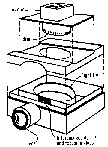MAKlNG A STREAK CAMERA
Note: This was my first "technical" article that was published in a professional journal and it came about mostly through the encouragement of Dr. Richard Zakia in the early 1960's for whom I prepared this work as a student project and who subsequently encouraged me to submit it to PMI magazine and William Hyzer for publication consideration.
The principle of the displacement or streak camera is quite simple.
Used to analyze motion in one direction only, perpendicularly to the direction
of a continuously moving film it records a spot of light reflected or originating
from the moving object. The streak camera plots the progress of motion
against time -the object's velocity and acceleration- and since exposure
is continuuus, it can record higher frequencies than intermittent or framing
cameras.
 The simplest streak camera
consists of a rotating film drum, a slit, and a lens. On the moving object
to be photographed, which is aligned so that it will always be at right
angles to the film and in range of the slit, is a light source or a reflector
illuminated by the source (unless the object is self-luminous). The reflector
can be a groove, a painted line, or a thin strip of reflective tape.
The simplest streak camera
consists of a rotating film drum, a slit, and a lens. On the moving object
to be photographed, which is aligned so that it will always be at right
angles to the film and in range of the slit, is a light source or a reflector
illuminated by the source (unless the object is self-luminous). The reflector
can be a groove, a painted line, or a thin strip of reflective tape.
Drum cameras are always "alert" to the initiation of an event, in contrast
to the other forms of streak cameras, the strip-recording camera, which
uses film wound on a spool and pulled past the slit. Also, the drum camera
has constant film velocity so that the acceleration of the film itself
does not enter into the final recorded result. However, the drum camera's
main drawback is that the event to be recorded cannot take longer than
one rotation of the drum. A larger drum will overcome this, but a more
elegant method is to use color film exposed through a multicolored filter
disk. With a tricolor disk (red, blue and green) rotating at one-third
the drum's speed, three overlapping traces will be recorded.
The drawing above shows how Andrew Davidhazy designed a simple drum
camera which he built out of heavy cardboard for about $14 in materials,
mostly for the lens and motor. Mr. Davidhazy, a student at Rochester Institute
of Technology, used the camera to study the duration and characeristics
of an exploding wire (photo below) and an electronic flash. The slope of
the edge of the flame in the photograph indicates velocity; velocity is
constant if the edge is straight, and decelerating if curved to the right.
The drum can hold film between 35 to 70mm in width, 12 1/8 inches long.
Film velocity, drum rpm and length of one exposure were calculated from
photographs taken of falling bodies over a known distance. The film velocity
past the slit is about 3500 inches per second; the 60-cycle motor rotates
at about 17,700 rpm. Using a llOmm (f/8) lens, the camera has a 1:3.5 image-to-subject
ratio. Since one rotation equals about 1/296 sec. this enables object velocities
up to 10,000 ips to be recorded.
 As reported in PMI (Photo
Methods for Industry) magazine , September 1963, Vol. 6 number 9 page 72
in conjunction with a a column written by William Hyzer on Photo Instrumentation.
As reported in PMI (Photo
Methods for Industry) magazine , September 1963, Vol. 6 number 9 page 72
in conjunction with a a column written by William Hyzer on Photo Instrumentation.
The photograph on the left was made with the above camera and shows the behavior over time of an exploding wire that was made (if I recall correctly) by making a weak spot in a some 22 gauge soldering wire and spanning it across the bared ends of a household extension cord. Plugging the plug into the household AC line caused the wire to vaporize at its thinnest point causing a brilliant flash in the process.



 The simplest streak camera
consists of a rotating film drum, a slit, and a lens. On the moving object
to be photographed, which is aligned so that it will always be at right
angles to the film and in range of the slit, is a light source or a reflector
illuminated by the source (unless the object is self-luminous). The reflector
can be a groove, a painted line, or a thin strip of reflective tape.
The simplest streak camera
consists of a rotating film drum, a slit, and a lens. On the moving object
to be photographed, which is aligned so that it will always be at right
angles to the film and in range of the slit, is a light source or a reflector
illuminated by the source (unless the object is self-luminous). The reflector
can be a groove, a painted line, or a thin strip of reflective tape.
